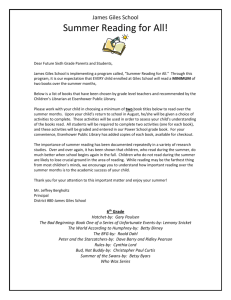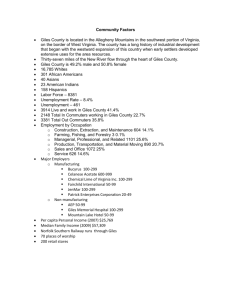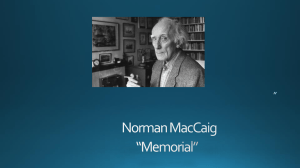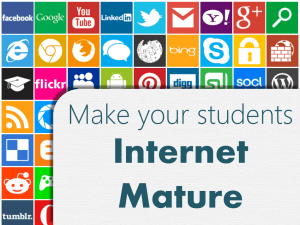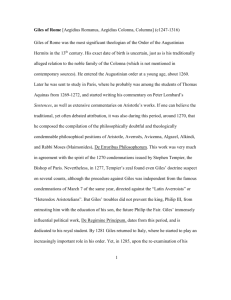Culture & Intercultural Communication
advertisement
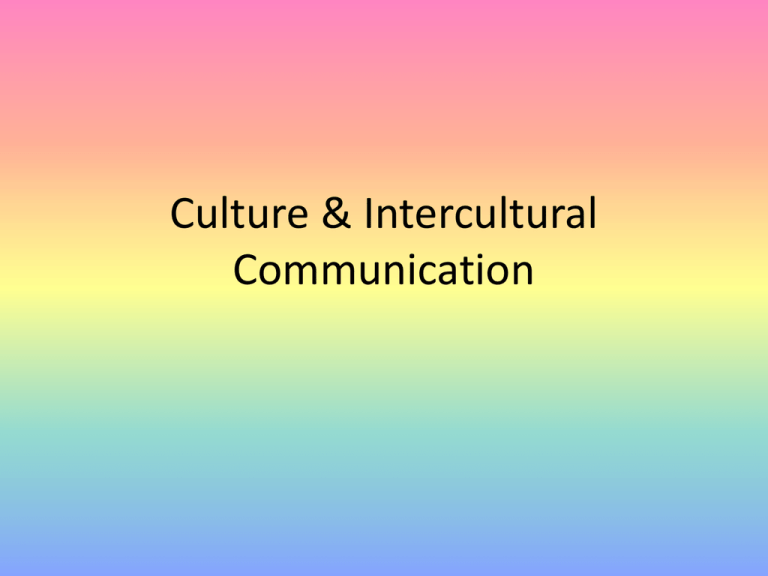
Culture & Intercultural Communication Communication and culture • How does culture affect the way we communicate? Create a brief list of ways in which culture can impact on our communication. “Every culture has rules that its members take for granted. Few of us are aware of our own biases because cultural imprinting is begun at a very early age. And while some of culture’s knowledge, rules, beliefs, values, phobias and anxieties are taught explicitly, most is absorbed subconsciously.” Carol Kingsy Goman Forbes Magazine 11/28/2011 Examples • http://www.youtube.com/watch?v=83nfRx6nf 0s • http://www.youtube.com/watch?v=nA0bqHJq PQE • http://www.youtube.com/watch?v=H-oHTELcLE The Communication Process • A message or communication is sent by the sender through a communication channel to a receiver, or to multiple receivers. • The sender must encode the message (the information being conveyed) into a form that is appropriate to the communication channel, and the receiver(s) then decodes the message to understand its meaning and significance. • Misunderstanding can occur at any stage of the communication process. • Effective communication involves minimising potential misunderstanding and overcoming any barriers to communication at each stage in the communication process. • http://www.youtube.com/watch?v=ZlcFB0NZ HLo Communication Channels • Communication theory states that communication involves a sender and a receiver (or receivers) conveying information through a communication channel. • Communication Channels is the term given to the way in which we communicate. • There are multiple communication channels available to us today, for example face-to-face conversations, telephone calls, text messages, email, the Internet (including social media such as Facebook and Twitter), radio and TV, written letters, brochures and reports to name just a few. Encoding Messages Decoding Messages Feedback • Receivers of messages are likely to provide feedback on how they have understood the messages through both verbal and non-verbal reactions. • Effective communicators should pay close attention to this feedback as it the only way to assess whether the message has been understood as intended, and it allows any confusion to be corrected. • Understanding is essential otherwise the interaction is not considered communication. • Communication can be described as an understood message between a sender and receiver. verbal and non-verbal communication Verbal Communication - A medium for communication that entails talking using the spoken word, such as talking face-to-face, on a telephone, or as a speech. Nonverbal Communication - A medium for communication that entails using cues via body language to convey message content. Facial expressions, body gestures, and voice intonation are forms of nonverbal communication. the role of communication in maintaining social relationships and social control The communication process carries messages in four basic directions: Downward: Communicat ion travels from superior to subordinate eg employer to employee Upward: Communicati on travels from subordinate to superior. Most common form is feedback Lateral: Communication takes place between people on the same level of hierarchy. Most common reason is to promote communication and teamwork. Gender roles and their place in the communication process. • Effective communication depends on shared communication. • Boys and girls are encouraged to develop different styles of communication; styles that conform to the masculine and feminine stereotypes. • In pairs, write down examples of the different stereotypes in relation to gender and communication. • • http://www.youtube.com/watch?v=JlypcNJ3YJo https://www.youtube.com/watch?v=q_eUC1nFZPs&index=1&list=PL726CF7020C6 04B81 (Ross and Rachel’s First Kiss) • Qualifiers: Qualifiers such as ‘somewhat’, ‘in my opinion’, maybe’, ‘perhaps’, and ‘sort of’ have typically been more indicative of women’s speech. They reflect the speakers uncertainty and weaken the statement the speaker is making. Disclaimers: • Disclaimers create a barrier to communication by separating the speaker from the listener. They are words or phrases that diminish a speaker’s statement or request, such as ‘I am probably wrong but…..’ They often precede statements for which the speaker does not wish to claim responsibility for. Tend to be used more by women. Tag Questions • This refers to the addition of tags to declarative statements, such as ‘isn’t that so?’ or ‘Don’t you think?’. These can be used to clarify information, elicit information, obtain feedback and persuade others. However, they can also be used to avoid asserting one’s ideas or beliefs which diminishes the speaker. Compound requests • These soften statements and make the speaker appear more polite and less assertive. For example, ‘If it wouldn’t be too much trouble..’. Women employ this technique more than men. Interruptions and overlaps • Refers to cases where individuals speak simultaneously. Studies indicate that regardless of status, context and relationship, women are more frequently interrupted than men are. There are also non verbal gender differences in communication. • Space or proxemics: It has been suggested that the early socialisation of males and females encourages boys to expect more space for themselves and girls to be happy sharing their space. Studies indicate that men enter women’s space more than women enter men’s spaces. Body Language and eye contact • At an early age girls learn to smile, tilt their heads, and sustain eye contact when engaged in conversation. Boys are socialised to monitor these behaviours. Touch or Haptics • Touch has many meanings. It appears that women receive more touch and are touched more by men, though contextual factors such as age and status may play a role. Vocal Cues or paralanguage • Judging and being judged by others is influenced largely by the way people express themselves (or how they sound). Five variables are: 1. More pitch variation 2. Greater volume 3. Faster speech 4. Shorter pauses 5. More hesitant speech Questions 1. Men and women speak different languages even when they use the same words. Identify two words or expressions that support this idea. 2. What role does physical appearance play in professional life? In what different ways does it affect men and women? • the impact of changing communication technologies on: • intra-generational interaction • language usage • cross-generational interaction • social interaction • cross-cultural interaction • globalisation. the individual’s rights and responsibilities in relation to communication, communication technologies and citizenship Communication technologies • Over the years, technology has significantly changed the way people communicate. • Originally, the telephone replaced the telegraph. • Now cellphones, email and the Internet top the list of preferred communication methods. • As more businesses and educational institutions use technology to communicate, society seems to have accepted, if not embraced, the increased role technology now plays in everyday life. Email • The email message is replacing handwritten correspondence in business and personal interactions. • People can send an email message and quickly get a response whereas sending other written correspondence may require a longer turnaround time. • One bonus of the email message includes saving on postage costs. Many providers, such as Google Mail and Yahoo!, provide free email accounts. Social Networking Sites • Internet-based social networking sites such as MySpace and Facebook allow people to communicate with friends, family, colleagues and even complete strangers in an online forum. • These sites allow people to share information and photos with others, regardless of the physical miles that otherwise may have prevented them from doing so. • This allows grandparents to see updates and pictures of grandchildren instantly, rather than waiting for the pictures to arrive in the mail. • In addition, the use of social networking sites allows people to reconnect with others they may have lost contact with over the years. Online Chat • The use of online chat forums allows people to converse with others across the street or across the country in real time without picking up a telephone. • Many email providers also provide chat capabilities as do social networking sites. • Other sites allow users to join chat rooms where they can communicate with complete strangers about a specific topic. • Sometimes people then share their phone number or email information with the people they meet while chatting online. Blogs • The popularity of blogging has increased over the years. • Businesses use blogs for promotional purposes, but individuals also have turned to blogging. • People now use blogs to share family journeys, to provide instructional information and just about everything in between. • Some people make a living blogging by selling the content provided and through advertisementbased revenue. Video Calls • Providers such as Skype and Yahoo Messenger offer the ability to use an Internet connection to place video calls. • These calls allow people to see one another on a computer or laptop screen while talking. • Placing video calls make it possible for families to see each other despite the physical miles that may separate them. • For example, a parent traveling on a business trip can still see and say goodnight to his children. • Businesses can save money by using video calls rather than traveling to specific destinations. CellPhones • The popularity of the cellular phone has increased in recent years because this portable telephone allows people to stay connected just about anywhere they may go. • In addition to placing and receiving voice calls, cellphones provide the ability to send text messages to other cell phone users, allow users to gain access to their email accounts and access social networking websites and send instant messages. Intergenerational communication and intra-generational communication • The term “intergenerational communication” applies to interactions involving individuals who are from different age cohorts or age groups. Families provide ready examples of individuals whose communication would be classified as intergenerational: parent and child, grandparent and grandchild, aunt and niece, to name a few. • These interactions stand in contrast to intragenerational communication or communication between individuals from the same generation or age cohort, such as siblings. How has technology changed intragenerational communication? • Think back and reflect over your life time. Has technology changed the way in which you communicate with your peers? • Have you always grown up with a mobile phone? Social media? • What barriers can you identify to communication that existed when you were little? Do these barriers still exist for you today? Why/why not? language usage and communication technologies • Technology’s role in our lives is astonishing. Its effect on the way we communicate has changed the English language forever. • To be more specific, the way we speak today is, by and large, the way we spoke before the internet became what it is, albeit with an enriched vocabulary. Conventions of telephone conversations have, to my mind, changed little: we still use the same methods – if not words – to greet and sign off, for example. • What is hugely different, however, is the way we write today. That is the area where technology has had the biggest impact. • Email altered the structure of the letter as a communicative tool. It brought with it a whole new etiquette, as well as new conventions and new abbreviations, such as IMO (in my opinion), FWIW (for what it’s worth), IIRC (if I remember correctly) and FYI (for your information). • And it introduced the idea that WORDS IN UPPER CASE MEAN WE ARE SHOUTING, while lower case writing is the accepted form. • But email English is nothing compared to the impact upon language driven by mobile phone users. The rate and extent of change this has had is truly astounding. • The way we write our text messages is now so widely accepted that it has infiltrated mainstream advertising. Here are two examples: • Virgin Media, the British company, ran a campaign several months ago for its provision of broadband (or Brdbnd, as it called it) and, a little more locally to me, a council campaign advised us: ‘Dnt B Wstfl’. • And then we have the meteoric rise of blogging. There are now well over 100million blogs worldwide. Add to that the even-morebaffling growth of the key social networking websites – MySpace, Bebo, Facebook – and we start to see the whole picture. The watchwords today are ‘user-generated content’ (UGC). • So, to sum up…email + texting + blogging + social networking sites = people writing more how they speak and less like they used to write. And, essentially, less like they had to write – either for a boss, a parent or a teacher. • Complete worksheets on “text talk” Communication Accommodation Theory strengths and weaknesses • In interpersonal situations, language can be used to convey information about one's personality, temperament, social status, group belonging, and so forth. • Although many of us like to think that we interact essentially the same way to virtually every person we encounter, thanks to fairness and our integrity, this simply is not true. • In most instances, it is desirable, and even necessary, to adjust our language patterns to our conversational partners, be they close friends or loathed felons • Sometimes we encode this deliberately and consciously, other times it emerges automatically and may not even be decoded overtly. • Communication accommodation theory (CAT), initially known as speech accommodation theory, was first developed by Giles in 1971 so as to explain how we manage certain facets of interpersonal communication, particularly, our choice of accents and dialects. • Indeed, it was originally conceptualized to mine more complex sociopsychological understanding of language choices than a mere recourse to people's socially normative dispositions ( Giles & Powesland 1975 ). • Over the years, and with various colleagues, Giles has elaborated and revised the theory in varying directions (e.g., Giles et al. 1991 ) and it has, according to many commentators, assumed the status of a major socio-psychological theory of language and social interaction (e.g., Tracy & Haspel 2004 ). • Everyone has a specific way of speaking towards different group. Either that towards the elderly, or towards teens, everyone eventually change, back and forth, on how they communicate and interact on different groups. Howard Giles 1972 quoted, “when people interact they adjust their speech, their vocal patterns and their gestures, to accommodate to others”. • Giles said that there are reasons on why we do this. Whether that to converge (to communicate in a similar way to the other individual) or to diverge (to communicate in an accentuated way to maximize oneself), we always find ourselves in situation where we want to be a part and also fit in to a group or try to be different than those in that group to preserve positive identity. • This theory basically tries to ‘accommodate’ for differences within situations. Let us see the examples below to briefly show Communication Accommodation Theory. • Convergence: (From the hit American sitcom comedy, Friends, by David Crane and Marta Kauffman) • https://www.youtube.com/watch?v=Fe61tMf VKrk#t=222 • Convergence is basically a process whereby the individual tries to change their speech styles just so they can become more similar to those they're interacting. The video shows Joey (Matt Leblanc) trying to act the age 19, which is 11 years younger from his real age, just to show that he could pull of being 19. Here, we can see how he shifts his whole personality, just so he can prove that he could pull off 19 when he's interacting with a 19 year old. • Clothing: before, he dresses up like a normal 30year-old, simple long pants and a buttoned up shirt. Now he's trying to look 19 by wearing how a typical 19 would wear during that time, which is far different from how he would wear clothes, a 30 year old. Communication: It is obvious that Joey changed his language into that of a 19 year old. He changed his speech patterns so that he could accommodate if he were to talk to a 19 year old. He even change his body language to suit the different context in the conversation, following him being 19. • Giles states "...it is probably safe to assume that these shifts resulted in a favorable appraisal of the speaker that is, they have created an impression that the speaker is trying to accommodate to his or her listener(s)". Divergence: (From the supernatural drama television series, Vampire Diaries, by Kevin Williamson and Julie Plec) • https://www.youtube.com/watch?v=gRNdsx7 ggmE • Giles and Coupland 1991, refers divergence as “the way in which speakers accentuate speech and nonverbal differences between themselves and others” Divergence talks about how a person change his behavior so that it differs from the other person and they have no intentions on accommodating the other. Divergence can also happen when a person wants to maintain some distance from another person. The video above shows how Stefan (Paul Wesly) is being a jerk towards Elena (Nina Dobrev). There's a reason why he's being a jerk. He used to be caring and loving towards her (typical romantic couple). But then it all change when the bad guy, Klaus (Joseph Morgan), forced Stefan to hate Elena because of certain reasons, or else he would kill her. • Stefan then change his way of communicating and treated her differently so she could hate him and thus easier for him to move on and not love her anymore. He is diverging so he can create distance between them. Griffin 2009, mentioned that with divergence, there are 'counter-accommodation', 'under-accommodation' or 'over-accommodation'.Counter-accomodation is basically a direct way of telling the other individual on their contrasts, and maximizing their differences. Under-accomodation is, to simply put it, not accommodating enough, or that the person ignores the other person's way of communicating. Overaccommodating is obviously the opposite, where the individual pays too much attention on the other person's communication style and engage onto an exaggerated compensation. Criticism of Communication Accommodation Theory • Giles’ theory is generally considered to be sound because few researchers have been able to successfully challenge it. • However, critics of the theory point out that conversations often seem to be too complex to be broken down into components as simple as convergence and divergence. • They also point out that people can use both techniques in the same encounter, a scenario that has not received much attention by researchers. • Finally, critics counter that Communication Accommodation Theory assumes that both parties are communicating in a rational manner. • They point out that people can and do become unreasonable and even irrational during conflict. • Critics charge that, as it stands, the theory does not deal adequately with this aspect of communication. Activity • Create a table in your books identifying both pros and cons for CAT PROS CONS Activity 2 • You are to find ONE example from popular culture of CONVERGENCE and ONE example of DIVERGENCE. • For each example, why was the technique used? • What was the outcome of using the technique? • Was it a positive or negative experience for the characters involved?
